Jongmyo Jerye is a ceremony held for the king and queens of the Joseon Period in the shrine where the ancestral tablets of theirs are preserved. Jongmyo, along with the rituals where services for the Gods of Earth and Corps were performed, is considered as an important symbol which is the foundation of national survival. It has Jeongjeon(Main Hall), enshrined 49 tablets in 19 spirit chambers, and Yeongnyeongjeon(Hall of Eternal Peace), enshrined 33 tablets in 16 spirit chambers.
Jongmyo Jerye was one of the five kinds of rites performed by the Joseon Dynasty's royal family. The five were classified as gillye (auspicious rites), hyungnye (funural rites), binnye (reception ceremonies), gunne (military rites), and garye (wedding ceremonies). The gillye includes the ritual service to the gods of heaven and earth and royal ancestral spirits. Besides the rite worshipping the royal ancestors, Jongmyo Jerye has also been dedicated to meritorious civil and military retainers.
It was classified into regular and extraordinary ceremonies. The regular ceremony was held in January, April, July, and October. Initially, an extraordinary ceremony was held when auspicious occasions and national disasters occurred, but after the liberation from Japanese imperialist rule, it was held on the first Sunday of May. As it was a model of all ceremonies for spirits, its order and procedures were very strict and solemn.
Jongmyo Jerye proceeded in an order of rehearsal → ancestral tablet placing → spirits welcoming → singwanrye → food presenting → first obeisance → second obeisance → last obeisance → sacrificial food and drink partaking → cheolbyeondu → mangryo → closing. Before Jongmyo Jerye, a monarch was prudent in his speech and action for 4 days and cleaned his body for 3 days. 'Filial piety' is one of the Confucian tenets and Jongmyo Jerye, as the national manifestation of filial piety, took the role of enhancing the solidarity of people and bringing them closer together through that very common denominator. Jongmyo Jerye, as a standard of art in Confucian society, is a valuable cultural asset and the music, dance, ritual vessels, and libation of foods of Jongmyo Jerye are essential manifestations of aesthetics of performing arts based on cosmic and Confucian principles.
Jongmyo Jeryeak, Royal Ancestral Ritual Music, was performed when royal people held a ceremony for the repose of their ancestors in the Shrine, just named 'Jongmyoak.' Each procedure of the ceremony was composed of various music such as 'Botaepyeong' and 'Jeongdaeeop,' songs called 'Jongmyoakjang' praising the civil achievements of the Joseon kings and their military exploits, and dances like 'Botaepyeong dance' and 'Jeongdaeeop dance.'
The music, which was initially created in the reign of the Joseon Dynasty's 4th King, King Sejong, was used in royal palace banquets, and then it was modified as suitable for the ceremony under Sejo's reign, which has been handed down to present. The music was performed in Jongmyodaejae, which was discontinued in 1946 and then resumed in 1971, on the first Sunday of May every year.
Jongmyo Jeryeak performed in Jongmyo Shrine consists of Botaepyeong, which has 11 music pieces, and Jeongdaeeop, which also has 11 music pieces. The musicians are divided into the upper terrace orchestra in the foreground, called the Deungga, and the lower terrace orchestra, called the Heonga. Some music pieces of Jongmyo Jeryeak have their roots in the Tang Dynasty and Song Dynasty of China, and some grew in the native environment. These three different styles of music pieces are played with different instrumental ensembles.
Line dances are performed to the orchestral accompaniment of Deungga or Heonga in accordance with ritual procedures. Line dances aim at delineating the harmony of the negative and positive cosmic forces of yin and yang while they shift between civil dance(Munmu), delineating the positive force of yang to praise the civil achievements of the Joseon kings, and military dance(Mumu), delineating the nature of negative force of yin to praise the military achievements of the Joseon kings, for which the hand-held props are changed appropriately.
Hundreds of officiants, musicians, dancers, and attendants all create the ensemble of this composite art reflecting solemnity and magnificence typical of Asia. That this original property has continued without impairment for 500 years makes it indeed rare, so that its value should be preserved as part of the world's intangible cultural heritage and its benefits should be shared with a broad range of people worldwide.
Jongmyo Jeryeak, Important Intangible Cultural Properties No. 1, was selected as 'Masterpieces of the Oral and Intangible Heritage of Humanity,' with Jongmyo Jerye, Important Intangible Cultural Properties No. 56 |
 |
'Pansori,' often referred to as Korean Opera, is a type of traditional Korean music which tells a themed story in the form of music theater, with two musicians sharing the spotlight- a singer ('sorikkun') and a drummer ('gosu'). The singer plays the central role through his singing, words, and body language while the drummer plays an accompanying role by providing the rhythm and shouting words of encouragement to add to the passion of the performance. With a distinct, inimitable sound, rhythm, and singing technique, Pansori is truly representative of Korea's unique cultural landscape.
|
| 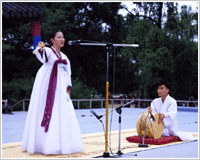 |
Pansori first emerged during the mid-Joseon era (1392-1910), when common culture began to evolve. The scribes of Pansori and the year of their origin are hard to pinpoint- it began as an oral tradition that was continued by professional entertainers. During the Joseon era, entertainers were regarded as lowly peasants, which explains why Pansori remained mostly in commoners' circles. But towards the end of the Joseon era, aristocrats took notice- and the audience for Pansori operas increased.
Originally a collection of 12 operas, there are now regrettably only 5 that have been passed down to us today- Chunhyangga, Simcheongga, Heungbuga, Jeokbyeokga, and Sugungga. A Pansori performance is lengthy, some even taking up to 4 to 5 hours to complete. In 2003, Pansori was officially recognized by UNESCO as an important piece of world culture. |
(* The 5 Pansori operas are called 'madang,' a word which literally means courtyard, but carries strong ties to traditional and folk games. In short, Pansori was considered a form of traditional play. The suffix of 'ga' at the end of each 'madang' name means 'song.'
Chunhyangga: The old novel 'Chunhyangjeon' in opera form. The love story of Sung Chunhyang, the daughter of a courtesan, and Lee Mongyong, the son of an aristocrat. Of the 5 Pansori 'madang,' it is valued the greatest in terms of musical and literary achievement. Famed portions of the opera include 'Sarangga' (love song), 'Ibyeolga' (farewell song), and 'Okjungga' (prison cell song).
Simcheongga: The old story of 'Simcheongjeon' in opera form. Simcheong, the daughter of a blind man who sought to regain her father's vision by offering rice at a temple, she sold herself to a boatman as a sacrifice to the ocean in exchange for the rice. The Dragon King of the sea, however, was touched by her love and rescued her, reuniting her with her beloved father. A child's love for their parent is the central theme of this story.
Heungbuga : The old story of 'Heungbujeon' in opera form. There are two brothers, Nolbu and Heungbu. Nolbu is older and wealthy, with a wicked heart. The younger brother, Heungbu, is poor but is a kind soul. When Heungbu comes into fortune by helping a swallow with a broken leg, the envious Nolbu purposely breaks the leg of a swallow and fixes it before setting it free in the hopes that he will be likewise awarded. The simple moral kernel of the tale is that kindness is rewarded and wickedness is punished.
Jeokbyeokga: A portion of the Chinese tale 'Samgukjiyeon' transferred into opera form. Famous songs include the 'Samgochoryeo' and 'Jeokbyeokgang River Battle.'
Sugungga: The old story 'Tokkijeon' in opera form. When the underwater Dragon King falls ill, he sends a sea turtle to land in order to find the liver of a hare to use as medicine. The opera contains much humorous banter between the characters. |
The Gangneung Danoje Festival is a traditional Korean festival which UNESCO designated as a masterpiece of human tradition and intangible cultural heritage on November 25, 2005. A Confucian sacrificial rite is performed at the Daegwallyeong Ridge Tutelary Deity Temple as the central event of the Gangneung Danoje Festival, the representative Korean festival held on Dano, the 5th day of the 5th month on the lunar calendar. The festival is held all over Gangneung City and Daegwallyeong Ridge; it stretches from the Danoje Festival grounds by Namdaecheon Stream which runs through the city of Gangneung - from the 20th day of the 3rd month on the lunar calendar when sacred liquor is brewed for the rite, to the 6th day of the 5th month on the lunar calendar when the rite finishes. Traditional games and performances such as a mask drama, a Dano shamanic ritual, swinging, and Yutnori (a Korean traditional game) can be enjoyed. Learning Dano folk songs or carving masks can also be directly experienced.
Even though Dano is a traditional holiday celebrated by both Koreans and Chinese, only the Gangneung Danoje Festival is designated as an Intangible Cultural Property in UNESCO's Memory of the World because Korea’s native culture and tradition vividly coexist in the festival. Among Korea’s cultural heritages, the royal ancestral sacrificial rite in 2001, Pansori (a traditional Korean narrative song) in 2003, and the Gangneung Danoje Festival in 2005, have been continuously registered as Intangible Cultural Properties in UNESCO's Memory of the World. |
|
 DANO DANO 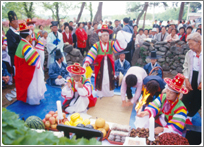
In Korea, there are two methods to determine the date, by using the solar calendar or the lunar calendar; thus, the dates on the solar calendar are different from the dates on the lunar calendar. Most of the traditional Korean holidays are dated on the lunar calendar, and an odd numbered day in the same odd numbered month has been thought to be a lucky day. Therefore, the 1st of January, the 3rd of March, the 5th of May, the 7th of July, the 9th of September, etc. on the lunar calendar have been chosen to be traditional holidays. Particularly, the 5th day of May on the lunar calendar is believed to be the most auspicious day because the celestial body of the universe converges on this date so that all the energies of nature are one. It is also believed that it is easy for young people to fall in love passionately on the day of Dano, the 5th day of May on the lunar calendar. As a result, young women have enjoyed swinging beautifully in traditional Korean dresses to attract young men’s attention. Likewise, men have participated in Ssireum (traditional Korean wrestling) to show their robustness and prowess.
In addition, the 5th month on the lunar calendar, the month of Dano, is around the time of the rainy season in Korea when bad diseases were easily spread in the olden days. Therefore, traditional customs to prevent various misfortunes have been passed down. Following superstitious customs of Dano for preventing evil spirits and misfortunes, women wash their hair in water infused with irises as well as wear red or blue dresses. For men, they put the roots of irises into the waist of their trousers. |
|
 Dano’s Traditional Customs Dano’s Traditional Customs
In the olden times, children took baths and adults splashed water on their backs to avoid the summer heat on the day of Dano. Noblemen were satisfied only when they put their feet into a water jar to maintain their dignity. Dano was a day to promote health and well-being right before summertime; as a result, on this day, there is a traditional custom of giving a folding fan to close acquaintances as a present, which means hoping for a healthy, cool summer. Furthermore, ancestors’ main entertainments on the day of Dano were swinging which was designated for women and wrestling which was designated for men. They also enjoyed a mask dance, a dance with a lion’s mask, and a mask drama. Because Dano is a representative traditional holiday just like Korean New Year’s Day, ancestors used to wear hanboks and pray for a good harvest on the day of Dano.
|
|
 Dano’s Traditional Food Dano’s Traditional Food
Dano’s traditional food is quite appetizing as well as nutritious and will ensure a good state of health during summertime. The rice cake made with wormwood or Surichwi (a kind of marsh plant) whose medicinal effect is the best in the summer, is a main dish served on Dano. There is a traditional custom where various kinds of rice cakes such as Ssuktteok (rice cake with wormwood), Manggaetteok (rice cake with supplejack), Yakchotteok (rice cake with medicinal herb), Surichwitteok (rice cake with marsh plant), and wheat flour pancakes are made to share with neighbors.
There is also cherry jelly made from cherries which are steamed and boiled in sugar as well as cherry punch made by mixing water and cherries preserved in sugar or honey. |
 |
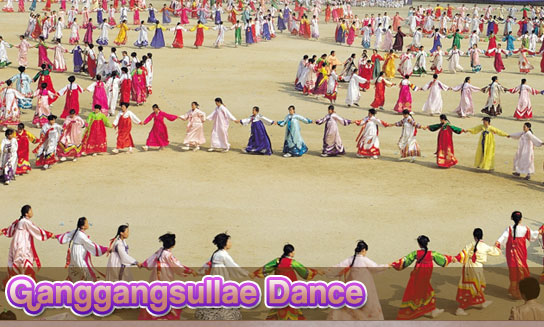 |
| All-Women Folk Dance |
|
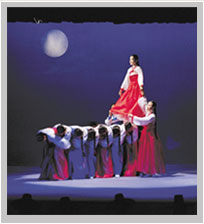 The southwestern coastal province of Jeollanam-do is home to Ganggangsullae, a Korean song and dance tradition performed by females around Chuseok holiday (Korean Thanksgiving) on the brightest night of the full moon. The southwestern coastal province of Jeollanam-do is home to Ganggangsullae, a Korean song and dance tradition performed by females around Chuseok holiday (Korean Thanksgiving) on the brightest night of the full moon.
Legend has it that ganggangsullae originated from a military strategy used against Japanese troops when they attacked Korea’s coastal regions. Following two Japanese invasions during the Imjinwaeran war against Japan between 1592 and 1598, Admiral Yi Sun-shin (1545~1598), then Naval Commander of the region, came up with a plan to deceive the enemy. He ordered dozens of local women to sing and dance gangangsullae around nighttime campfires on the mountainsides along the coast causing the Japanese to overestimate the strength of the Korean troops and retreat.
In a more general sense, ganggangsullae is considered a folk game, part of the age-old tradition of dancing and singing to celebrate the brightest full moon of the year. It expresses the exuberant spirit of women at a time when there were few such outlets for them. At the same time, it conveys the spirit of the Korean people beautifully. |
| |
| Dancing Ganggangsullae |
|
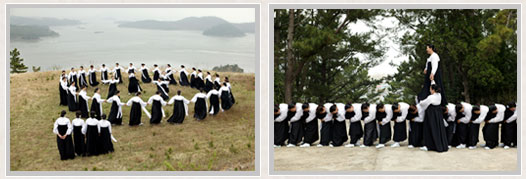 |
As the full moon begins to rise in the sky, women come together and move in a circle, hand-in-hand thrusting their right hands forward and their left hands back. The woman with the best voice sings first, followed by others who chant the repeated refrains of “ganggangsullae”. The leader’s singing is actually an improvisation. In the beginning, the dance movement and song tempo are slow, but the pace becomes more rapid, and soon the women appear to be running in a circle.
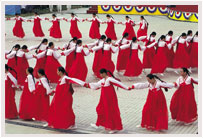 The dancers usually maintain a circular movement, but there are other variations. For example, a dancer can walk into the center of the circle in a dance called namsaenginori. Or, one can start rolling inside the circle mimicking a snail, and then turn the direction around to unwind from the center out in what is called meongseongmari. The dance is not bound by any specific order, but can change at the will of the leader. The dancing continues from start to finish as a kind of joyful merry-go-round. The dancers usually maintain a circular movement, but there are other variations. For example, a dancer can walk into the center of the circle in a dance called namsaenginori. Or, one can start rolling inside the circle mimicking a snail, and then turn the direction around to unwind from the center out in what is called meongseongmari. The dance is not bound by any specific order, but can change at the will of the leader. The dancing continues from start to finish as a kind of joyful merry-go-round.
This precious traditional dance was designated as an Important Intangible Cultural Property of Korea in 1966, and went on to become a UNESCO Intangible Heritage of Humanity in 2009. |
| |
|
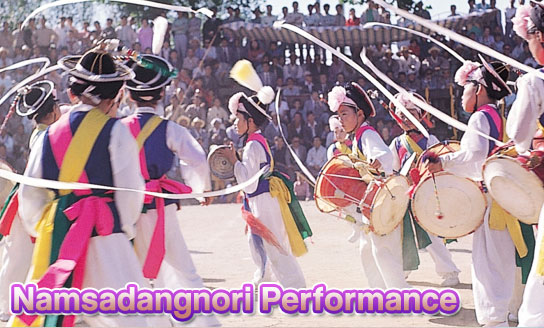
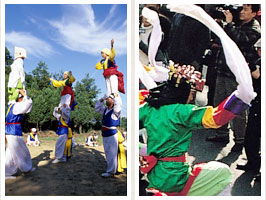 Namsadangnori (남사당놀이) generally refers to performances staged by Namsadangpae (남사당패), a vagabond troupe of 40 or more male performers. After the Joseon Dynasty, Namsadangpae troupes performed nationwide and were especially popular until the 1920s. Playing vital roles in the production were the kkokdusoe (leader), hwaju (performance planner), tteunsoe (music/dance planner), gayeol (performers), ppiri (trainees) and porters.
Namsadangnori (남사당놀이) generally refers to performances staged by Namsadangpae (남사당패), a vagabond troupe of 40 or more male performers. After the Joseon Dynasty, Namsadangpae troupes performed nationwide and were especially popular until the 1920s. Playing vital roles in the production were the kkokdusoe (leader), hwaju (performance planner), tteunsoe (music/dance planner), gayeol (performers), ppiri (trainees) and porters. 
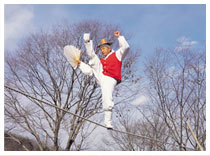 Tightrope walking, or eoreum, comes from the Korean word for ice, which is an indication of how difficult the practice is. Deotboegi is a type of mask dance. Finally, deolmi is a puppet performance. Several types of deolmi were popular at the time: kkokdugaksi noreum, bakcheomji noreum, and hongdongji noreum. Of those, kkokdugaksi noreum is still performed today. Namsadangnori is the last vestige of Korea’s traditional puppet tradition, and thus holds great historical significance. These performances are said to have started around 9 pm in the evening and lasted for 6 or 7 hours until 3 or 4 in the morning.
Tightrope walking, or eoreum, comes from the Korean word for ice, which is an indication of how difficult the practice is. Deotboegi is a type of mask dance. Finally, deolmi is a puppet performance. Several types of deolmi were popular at the time: kkokdugaksi noreum, bakcheomji noreum, and hongdongji noreum. Of those, kkokdugaksi noreum is still performed today. Namsadangnori is the last vestige of Korea’s traditional puppet tradition, and thus holds great historical significance. These performances are said to have started around 9 pm in the evening and lasted for 6 or 7 hours until 3 or 4 in the morning. 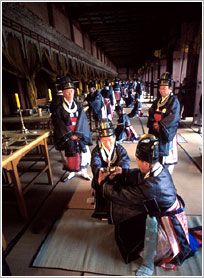
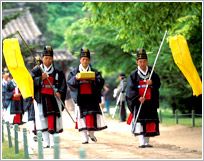
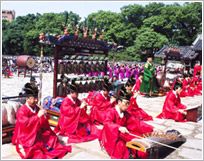

 DANO
DANO 
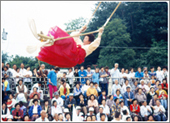
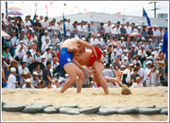
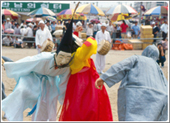

 The southwestern coastal province of Jeollanam-do is home to Ganggangsullae, a Korean song and dance tradition performed by females around Chuseok holiday (Korean Thanksgiving) on the brightest night of the full moon.
The southwestern coastal province of Jeollanam-do is home to Ganggangsullae, a Korean song and dance tradition performed by females around Chuseok holiday (Korean Thanksgiving) on the brightest night of the full moon. 
 The dancers usually maintain a circular movement, but there are other variations. For example, a dancer can walk into the center of the circle in a dance called namsaenginori. Or, one can start rolling inside the circle mimicking a snail, and then turn the direction around to unwind from the center out in what is called meongseongmari. The dance is not bound by any specific order, but can change at the will of the leader. The dancing continues from start to finish as a kind of joyful merry-go-round.
The dancers usually maintain a circular movement, but there are other variations. For example, a dancer can walk into the center of the circle in a dance called namsaenginori. Or, one can start rolling inside the circle mimicking a snail, and then turn the direction around to unwind from the center out in what is called meongseongmari. The dance is not bound by any specific order, but can change at the will of the leader. The dancing continues from start to finish as a kind of joyful merry-go-round.
댓글 없음:
댓글 쓰기